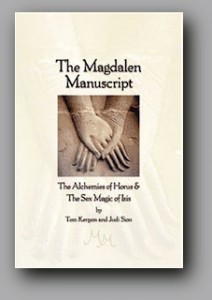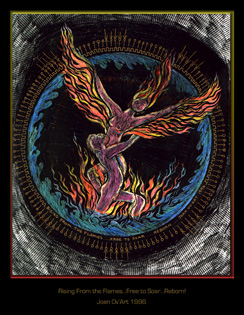Like all types of alchemy,
there must be a container
for the reactions to occur.
And in this case,
it is the container of
safety and appreciation
that provides the
reservoir for transformation.
The Alchemy of Relationship
by Tom Kenyon
This article was taken from the
Magdalen Manuscript
(ORB Communications).
The Alchemies of Horus and
The Sex Magic of Isis
by Tom Kenyon and Judi Sion
Many of us do relationships
the way we play poker.
We do everything possible
to get the upper hand.
And if that fails, we bluff.
We pretend to hold cards we don’t have.
We cheat.
We lie.
And while this is the model for many a relationship in our post modern era, it is not the model for Sacred Relationship as described in the Manuscript.
Let me be very up front here.
Sacred Relationship is
not for everyone.
In fact, I suspect that there are
far fewer persons capable
or even willing to undertake it
than there are those
who prefer to play
emotional card games.
This type of relationship
demands utmost honesty
both with oneself and
with one’s partner.
Instead of hiding our cards,
we lay them all out on the table.
All our hopes,
all our fears,
all our petty
and jealous thoughts,
all our conniving:
all of it gets laid out in the
clear light of awareness
for our partner to see.
And he or she must do the same.
It will not work if there are back doors
unlocked with mental escape in mind.
It will not work if both partners are not
absolutely impeccably honest
with each other.
And the reason for this radical type of honesty is that without it, the Alchemy of Relationship cannot take place. Now this may be a new term to many, even students of internal alchemy, since the dynamics of intimate relationship are rarely discussed in the four major alchemical streams (Egyptian, Taoist, Yoga Tantra and Buddhist Tantra).
So I think it might be good to define what I mean here, and to lay some type of foundation. Like all types of alchemy, this type of work is about changing one form into another. The form, in this case, is the inter-dynamics that have become habituated between two people. After a while, people tend to get into ruts. The liveliness that existed at the beginning of the relationship begins to fade. Both people become more or less unconscious. The harsh reality is that it takes continual vigilance and effort to keep a relationship conscious and alive.
Many relationships drop by the wayside because the partners are either unwilling or unable to make the efforts required to sustain them. Instead of experiencing the newness of each moment within the relationship, a kind of dullness seeps in over time; what used to be exciting is now boring. And worse, a kind of psychological and emotional lethargy sets in, and both partners succumb to the dulling effects of unconsciousness.
This type of unconsciousness is a death knell to psychological awareness and insight; and although it is rarely mentioned, this type of unconsciousness has a negative effect on one’s spiritual life as well.
So the form that needs
to be changed
within a relationship
is literally the form of interactions
that habitually take place
between the two partners.
Like all types of alchemy,
there must be a container
for the reactions to occur.
And in this case,
it is the container of
safety and appreciation
that provides the
reservoir for transformation.
If there is a lack of
safety or appreciation,
this type of alchemy
cannot be undertaken.
And if you have decided
you wish to try this
type of alchemy
in your relationship,
I suggest you do an
analysis first.
Honestly assess if you
feel safety and appreciation
in your relationship.
If you don’t, you will be wasting your time trying to undertake this type of alchemy with your current partner. I suggest you focus your efforts, instead, on the solitary practices mentioned in the Manuscript. If you still want to give it a try, get your partner to talk about these feelings of danger and lack of appreciation that you are feeling. Only if and when they get resolved, should you consider taking on this type of alchemy.
So now we have two of the three elements needed for alchemy: something to be transformed (the habitual patterns of interaction) and the container (the safety net, if you will, of the relationship itself). A third element is needed; and that is, of course, energy to drive the reaction. There is usually plenty of energy in relationships in the form of neurotic patterns, hopes, fears, and desires. We’ll get to those in a moment, but for now I want to talk about steel.
Our psychological selves are much like swords made from steel alloys. They have been forged in the hot searing foundry of our childhood, in the formative pressures of our early experiences. It is this early period of life that bonds the elements of our psyches together. And like steel, this was done under immense heat and pressure.
Some of us were abused by overbearing or downright hostile or even destructive parents. Some of us were left to our own devices without any kind of support or guidance. And every kind of parental/child relationship falls in between these two polarities. The possibilities of childhood pressures are virtually endless, and so too are the psychological alloys that result from these types of experiences.
There is a lot of talk about the child within in many personal growth groups, and while there is certainly value in making contact with this younger self, it is not always pretty. Our cultural myth is that childhood is a time of innocence, a time in which everything is right with the world. For some children this is true; for many it is definitely not.
I remember being at a fellow therapist’s house for a party quite a few years ago. Most of the adults were practicing therapists, psychologists or psychiatrists. I had plopped myself in a big oversized sofa, and, sipping my Pepsi, I noticed a remarkable event. One of the therapists had brought his son and his son’s best friend to the party. It was clear that the two boys were buds. They were playing some kind of card game and respectfully giving each other a turn. There were no attempts at cheating, and they seemed to be in a bubble of camaraderie.
Then the boy’s father came into the room and asked both kids if they needed anything. They both looked up with cherub faces and smiled. No they said, in the cutest little boy voices. The father patted his son on the back, and as he walked off, he nonchalantly patted his son’s friend on the back as well. For a moment, his son looked at the incident in abject horror. You could see that he could not believe his eyes. And then as his father turned the corner into the other room, his son pulled back and hit his best friend in the face!
This was not childhood innocence. This was childhood rage. He was not willing to share affections from his father, not even with his best friend. This type of jealousy is typical of higher mammals, and we are, for all our self-righteous self-congratulatory delusions, still mammals. No matter how high we get spiritually, we will, for as long as we live, share traits with our mammalian brothers and sisters.
The inner life of a child
is often far different
than those around him or her
imagine it to be.
Surrounded by both
dangers and opportunities,
the psychological life
of a child is directly shaped
by how he or she
chooses to deal with them.
Whether it is something as life threatening as a deranged parent or a child molester, or seemingly innocuous as whom to go to the prom with, does not in some ways matter. While the impact of fighting for one’s life may very well imprint a child’s behavior well into adulthood, the little decisions of life, like who to socialize with or not, also have impact.
All these major and minor decisions
create internal psychological
heat and pressure.
The alloys of one’s personality
get bonded together or burned away.
The sword has been tempered
by the time we reach adulthood,
and the alloy of our personalities
has been set.
Some of us emerge from this childhood foundry with rock hard edges; others of us are blunt. Some of us hold our edges, and some of us can never seem to hold anything.
The thing about steel is that it
tends to remain in its original form
once it leaves the foundry.
And one of the few things
that can ever re-configure
the alloy is if the steel
gets as hot as it did
when it was first formed.
In the alchemical work
of Sacred Relationship,
we voluntarily put ourselves
back in the foundry.
The heat that arises
between two people
when their neuroses
rub against each other
can get quite intense.
If both people can find
the courage to be radically honest
with themselves and
with each other
in these searing moments,
the psychological alloys
can be altered.
A new type of aliveness
then enters the relationship
fueled by the energy
of psychological truth.
The thing is–most of us
will do almost anything
to avoid psychological heat.
When we get uncomfortable,
many of us
get the hell out of Dodge.
Now for some of us this means literally packing up and getting out of town, or at least out of sight. For some of us it means that we are physically present, but no longer emotionally present. We numb up. We become automatons. We move and talk, almost like normal, but we have retreated far, far inside. Others of us numb ourselves with alcohol or drugs. And some of us do it with television.
We humans are, after all, quite clever and creative. We can find all sorts of ways to avoid facing ourselves. In fact, they are far too numerous for me to list here. But I suspect you get the idea. I guess the real question here is this–what do you do when things get psychologically too hot for your taste? What do you do when you are on the verge of feeling something that you don’t want to feel?
For those in Sacred Relationship
such feelings are
a call to presence.
It is a time to be radically honest,
and for both partners
to express their true feelings
no matter how embarrassing
or scary they might be.
By speaking their truths
to each other,
an enlivening element
enters the dynamic.
Psychological honesty
results in
psychological insight.
And with insight there is
hope for awareness,
and with awareness
there can be change.
This chapter is hardly a manual for the Alchemy of Relationship. It’s mainly, I think, a warning. Magdalen alluded to this in the Manuscript. She called it obscurations to flight. That sounds wonderfully exotic doesn’t it? Well, it isn’t very exotic when the obscuration is clearly in your face.
And it isn’t very exotic feeling
when the foundry of the relationship
gets so hot that you feel
you are dissolving
(psychologically that is).
It takes courage and fortitude
to stay in the foundry
when the heat begins
to weaken the stability
of one’s self-perceived image.
Few of us care to look foolish,
scared, petty or jealous.
And we will often go through
elaborate means
to hide these feelings
from ourselves or others.
But in Sacred Relationship
these things invariably float
to the surface like mud
that has been stirred up
from the bottom of a barrel.
The thing is to realize
that this does not mean
you are doing it
(Sacred Relationship)
wrong; it means that
you are probably doing it right.
As Magdalen said in the Manuscript,
the power of the alchemy
extrudes, or pushes out, the dross.
This can be fascinating
when the dross is being
pushed out of your partner,
but it is truly horrific
when it extrudes out of you.
What makes Sacred Relationship sacred is that it is truly a holy way of being. The root of the word holy actually means to make whole. So… when we do something that creates wholeness (in this case psychological wholeness), we are engaged in a sacred or holy act.
In the crucible of mutual safety,
honesty and appreciation,
it is possible to forge
a new kind of self.
This new self is
psychologically more honest,
more aware and freer
than its counterpart
before entering the
foundry of relationship.
And like the phoenix that
arises from its own ashes,
this self has wings.
It can fly places that it could
only imagine before.
There are mysteries here,
and treasures that await
those who have the courage
to enter the depths
of themselves
and their partners.
It is not, as I said,
for everyone.
You will probably know
if you are a likely candidate
because you will feel it
in your soul, your heart.
If you enter this path,
know that there are
no manuals.
There is precious
little guidance out there.
The path to spirituality has traditionally been one of solitude. And while times of solitude may be necessary for those in Sacred Relationship, something has turned.
They agree to walk the path to godhood together, side by side, through both heaven and hell, through the brilliant summits where all things are suddenly crystal clear, and through the dark valley of psychological death where it is hard to even see one’s foot in front of the other.
And yet through the darkness
of not knowing,
a deep primordial force
begins to rise up.
It requires an unusual
type of holy trinity –
three things for it to do
its most holy task-
mutual safety,
psychological honesty
and
appreciation of the Beloved.
Have a good journey!
© 2010 Tom Kenyon. All rights reserved.
You may make copies of this message and distribute in any media as long as you change nothing, credit the author, and include this copyright notice and web address: http://tomkenyon.com/alchemyofrelationship










